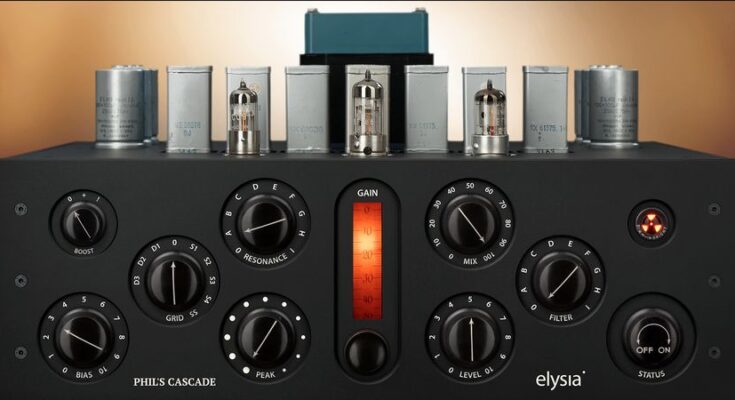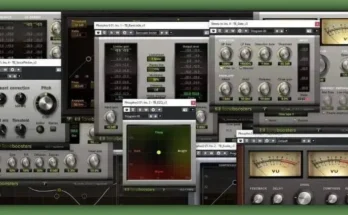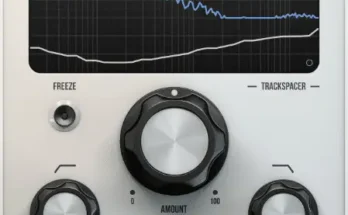Phils Cascade v1.3.0 WIN
TeamCubeadooby | 21 March 2023 | 10 MB
Phil’s Cascade is based on highly esoteric vintage components combined in a truly unique circuitry. It is anything but your typical audio processor. Phil’s Cascade is an amazing toolbox which will open the world for creating the most interesting sound flavors.
The beauty of this approach is that it did not have to follow any rules at all. Phil’s Cascade uses very interesting NOS (New Old Stock) components which are everything but standard in audio applications, and the novel circuitry is a creative celebration of its own. All in all, this gives you the perfect basis for creating truly wonderful, new and unheard sounds.
Now you can spice up virtual and natural instruments at ease, transmuting standard sounds with all kinds of gritty, organic and aged flavours. There are no right or wrong settings: Saturation, harmonics, distortion, colouration, filtering, interaction, anything goes, and experimenting is as much encouraged as it is rewarding.
elysia phil’s cascade – Changelog
Version 1.2 (Feb 19, 2020)
– Fixed Crashes in Cubase 10 after Session Save Reopen and Deinstantate
– Fixed an issue where moving knobs through the mousewheel scrolling could move other controls too (scaled modes and Cubase + Win10 only)
– Fixed crashes in Logic (and potentially other DAWs)
FEATURES
- Components
Experiencing true vintage sound goodness from a 21st-century device relies on A) the exclusive use of components made decades ago and B) using them in old-school topologies with some interesting twists.
- Transformers
The NE and NX series transformers made by Philips in 1975 were actually never meant to be used in audio environments. However, first experiments quickly revealed they perform like real rock stars, now building the core ingredients forming the unique sound of Phil’s Cascade. There definitively is a lot of iron in this signal path!
- Tubes
Beyond the few tube types which are still available for serial production these days, the rabbit hole of weird, amazing and yes, magic NOS tubes couldn’t be any deeper. All made by Philips a long time ago, the ECC91, EF183 and EF86 are everything but your typical audio tubes and that’s exactly what makes them so valuable, as their special sound signature is plain and simple, unique.
- Power
Hardware rule #1: The heart of any audio device shall be its power supply! The 12 lb. power transformer used for Phil’s Cascade originally comes from vintage Tektronix measuring equipment, surviving the times when even this was based on tubes exclusively. With its many windings and taps, this mothership of a transformer is perfect for a multi tube-driven project.
- Capacitors
Old electrolytic caps can really suck. These, however, are in still in great shape. Made by Roederstein (ROE) way before the company was acquired by Vishay and in a time when even ‘smaller’ capacities came in a considerable footprint. Anyway, this batch of truly beautiful caps offer all the capacity needed for Phil’s Cascade – and then some!
- Rotary cap
What a stunning piece of engineering art! Rotary capacitors like this were used in old tube radios. What a beast for realizing just a single function. The scale is especially stunning on this one, and as a wonderful detail, it is backlit by a small E10 light bulb. After a little bit of modification, this historic piece became the central gain controller and an indicator of Phil’s Cascade.
- Knobs
Phil’s Cascade is controlled by a set of authentic bakelite knobs, made in the US many decades ago. Just a few of the knobs in this batch (a lucky find) were in such great condition, only showing signs of their respective age, but no significant discolourations or cracks. Against the odds, not only two different sizes but also a single On/Off knob were found inside the dusty old box.
- Light
Some icing on the cake. This pilot light is very rare new old stock made around the 1950s. It shines a truly significant shape of light, and it perfectly fits the aesthetics of the exclusive housing designed for Phil’s Cascade. But the wildest aspect about it is the light intensity which can be dimmed down mechanically, until just a super tiny spot in the middle of the lens remains.




